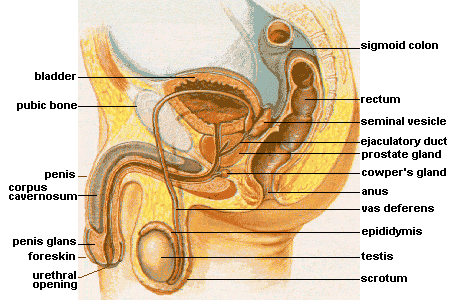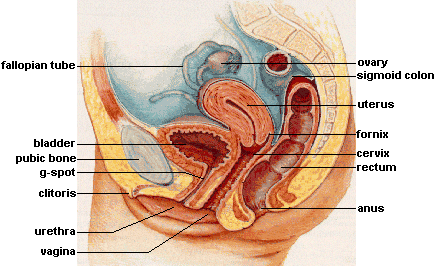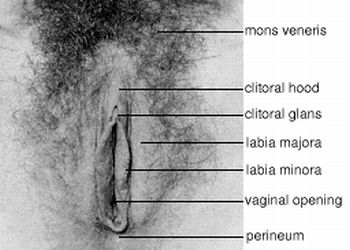Sex organ
- This is an article about Human Anatomy
A sex organ, or primary sexual characteristic, narrowly defined, is any of those anatomical parts of the body (which are not always bodily organs according to the strict definition) which are involved in sexual reproduction and constitute the reproductive system in a complex organism; namely: Sex organ (Look up Sex organ in Wikipedia or Wikitionary)
Male
|
Female
|
|
The Latin term genitalia (sometimes anglicized as genitals) is used to describe the sex organs, and in the English language this term and genital area are most often used to describe the externally visible sex organs, known as primary genitalia or external genitalia: in males the penis and scrotum, in females the vulva.
The other sex organs are called the secondary genitalia or internal genitalia. An even wider notion, subjective but always prominently including the genitalia, is erogenous zones.
Gonad(s) is a sex organ that produces gamete(s), specifically the testis^ or ovary^ in humans.
Organs of sexual anatomy originate from a common anlage^ and differentiate into male or female sex organs. The SRY^ gene^, usually located on the Y chromosome* and encoding the testis determining factor^, decides the direction of this differentiation. Each sexual organ in one sex has a homology (biology)^ counterpart in the other one. See a list of homologues of the human reproductive system^.
The following is a list of anatomical terms related to sex and sexuality:
- areola*
- Bartholin's gland^
- breast*
- bulbocavernosus muscle^
- bulbospongiosus muscle^
- bulbourethral gland^
- cervix*
- Cleft of Venus^
- clitoris*
- common penile artery^
- corona glandis^
- corpora cavernosa^
- corpus cavernosum^
- corpus spongiosum^
- Cowper's glands^
- cremaster muscle^
- dartos muscle*
- ductus deferens^
- ejaculatory duct^
- endometrium^
- epididymis^
- Fallopian tube^
- foreskin^
- frenulum*
- frenulum preputii penis^
- frenulum labiorum pudendi^
- frenulum clitoridis^
- frenum*
- fundiform ligament^
- G-Spot^
- Gartner's duct^
- genital tubercle^
- genitofemoral nerve^
- glans*
- glans penis*
- Gräfenberg spot*
- hymen^
- internal pudendal artery^
- ischiocavernosus muscle^
- labium^
- labia majora*
- labia minora*
- mammae^
- mammary gland^
- meatus*
- mons pubis^
- mons veneris^
- Mullerian duct^
- nipple*
- ovary^
- ovum^
- oviducts^
- penis*
- perineum*
- prepuce*
- prostate*
- pubic hair*
- pubic symphysis^
- pubococcygeus muscle^
- pudendal nerve^
- raphe^
- ridged band^
- scrotum*
- seminal vesicles^
- semeniferous tubules^
- Skene's glands^
- sperm*
- spermatic cord^
- sphincter urethrae membranaceae^
- splanchnic nerves^
- testes*
- testicle*
- tunica albuginea (testicles)^
- urethra*
- urethral sponge^
- urogenital diaphragm^
- [[Wikipedia:uterus|uterus]]^
- vas deferens^
- vagina*
See also
Chat rooms • What links here • Copyright info • Contact information • Category:Root


